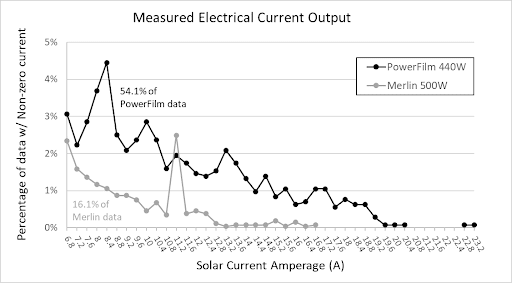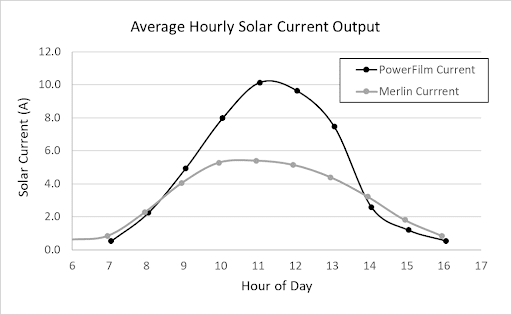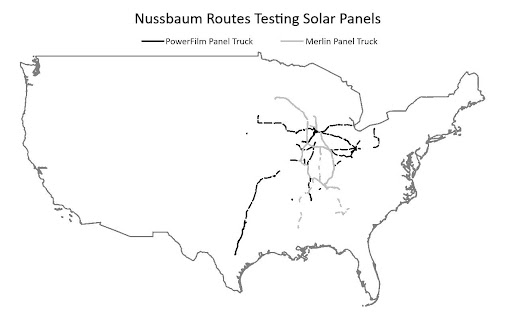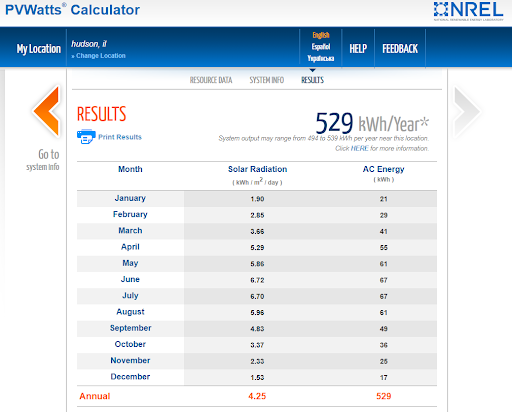PowerFilm vs. Merlin: Real-World Fleet Testing Proves PowerFilm Solar Panels Deliver More Power and Lower Costs for Trucking Fleets
.png?width=500&height=300&name=Blog%20Post%20164%20PowerFilm%20vs.%20Merlin%20Nussbaum%20Fleet%20Testing%20Shows%20PowerFilm%20Wins%20on%20Power%2c%20Efficiency%2c%20and%20Cost%20(1).png)
Fleet Solar Testing That Delivers Real Results
In the world of solar panels for trucking fleets, performance isn’t theoretical – it’s measured on the road.
Nussbaum Transportation, a nationally recognized carrier known for sustainability and efficiency, partnered with PowerFilm Solar to conduct a comprehensive, real-world fleet solar testing comparison between PowerFilm and Merlin solar technologies. The results clearly demonstrated that PowerFilm’s flexible, lightweight solar panels outperform Merlin in power generation, efficiency, and overall cost.
Our commercial trucking solutions use Maxeon solar cells, known for their exceptional efficiency and durability – a key reason PowerFilm produces more usable power under real-world conditions.
This blog unpacks how Nussbaum’s test validated PowerFilm’s superior performance, providing fleet managers and OEMs with reliable data to inform solar integration decisions.
Take this blog post with you!
Challenge: Finding the Most Efficient Solar Panels for Commercial Trucking
Nussbaum’s objective was simple: determine which solar panel system delivers the best power output and ROI under real operating conditions. Both systems were installed on Freightliner tractors equipped with electric auxiliary power units (EPUs) to measure solar-assisted battery charging performance across routes, weather, and geographic conditions.
The comparison tested:
- PowerFilm 440W Freightliner solar panels and charge controllers
- Merlin 500W Freightliner solar panels and charge controllers
Each system was evaluated for power generation, charging efficiency, and total economic value over an extended testing period.
For related applications, see solar panels for transportation refrigeration units (TRUs), which explores how solar supports cold-chain operations, and how solar power enhances liftgate reliability in commercial trucking, showing how fleets use solar to prevent downtime and improve delivery efficiency.
Test Setup: Controlled and Data-Driven
To ensure unbiased data, Nussbaum equipped four Freightliner tractors with identical high-resolution data-logging systems.
Each truck included:
- A 300A Victron current shunt to capture current and voltage into the EPU batteries
- A Victron Cerbo GX logger recording data every 15 minutes
- Cellular connectivity for real-time uploads and SD card backups
- Integrated GPS antennas for correlating solar performance with route and weather conditions
The test ran from November 15, 2024, to February 7, 2025, covering multiple geographies and sunlight conditions. Data was analyzed using Victron’s web portal and verified for consistency across vehicles.
For insights on performance while trucks are in motion, see solar panels working while driving.
Measuring Output: Current Delivered to the Battery
Detailed current analysis revealed:
- 54.1% of PowerFilm readings exceeded 6.8 amps, compared to only 16.1% for Merlin.
- PowerFilm maintained a stronger charging current across all weather types and daylight conditions.

These results demonstrate PowerFilm’s superior ability to capture diffuse light and maintain performance during overcast or shaded conditions—a crucial advantage for solar panels on long-haul trucks.
Average Charging Current: Consistency Under All Conditions
PowerFilm panels consistently generated higher charging current throughout the day, particularly between 10 a.m. and 2 p.m., when sunlight was strongest. Merlin panels showed notable output drops during peak sunlight, likely due to higher internal resistance and suboptimal temperature coefficients.
Even during low-sunlight months, PowerFilm’s efficiency edge remained steady. Extrapolations based on solar illumination data indicate that the performance gap would widen further during summer, when longer daylight hours enhance PowerFilm’s output advantage.

Test Locations and Route Verification
GPS tracking confirmed that both test vehicles operated within similar regions. This eliminated geographic bias and validated that the performance differences stemmed solely from panel design and material efficiency.

Cost and Efficiency Analysis: PowerFilm Lowers Cost Per Watt

Table 1: Solar illumination (Radiation) data for Hudson, IL, per NREL
Using NREL solar radiation data and PV Watts modeling, PowerFilm translated test data into measurable cost-per-watt values.

Table 2: Comparison table for PowerFilm v Merlin.
Key findings:
- PowerFilm was 1.47× less expensive per watt of usable delivered power.
- Normalized for output, PowerFilm produced 69% more effective power than Merlin.
- Real-world flexibility and lower resistance delivered measurable performance and cost advantages.
For a deeper dive into the financial implications of solar for commercial trucking, see What’s the Return on Investment for a Commercial Trucking Solar Solution.
Why It Matters for Fleet Managers
For trucking fleets integrating solar panels, these findings underscore the practical ROI of PowerFilm’s flexible solar technology:
- Increased usable power across weather and geographies
- Lower cost per watt of delivered energy
- Improved EPU battery uptime and longevity
- Fewer jump-start events and reduced maintenance costs
For more on how PowerFilm panels perform in the harshest conditions, read Can Solar Panels Handle the Toughest Road Conditions? A Look at Durability in Commercial Trucking.
Fleet operators can also explore strategies to mitigate parasitic battery draw in trucking fleets to further extend battery life and reliability.
By maximizing charging current and uptime, PowerFilm helps fleets cut idling, extend battery life, and enhance sustainability metrics—all without increasing system weight.
Conclusion: PowerFilm Outperforms Merlin in Every Category
Nussbaum’s fleet testing proved what PowerFilm customers already experience in the field: PowerFilm’s solar panels for trucking fleets outperform higher-rated systems in power, reliability, and cost-efficiency.
Fleet operators adopting PowerFilm’s technology can expect measurable gains in performance, lower total cost of ownership, and dependable energy delivery across all climates.
Ready to see the same results in your fleet?
Contact our team to explore a customized solar fleet solution today.
Frequently Asked Questions
Q: How did PowerFilm outperform Merlin in fleet solar testing?
A: In side-by-side testing on Freightliner tractors, PowerFilm delivered 1.49× higher power output and maintained charging efficiency in all weather conditions, outperforming Merlin despite lower rated wattage.
Q: What makes PowerFilm solar panels more efficient for trucking fleets?
A: PowerFilm panels feature flexible construction, low internal resistance, and optimized electrical configuration, allowing them to maintain output even in low sunlight and non-ideal orientations.
Q: How much can trucking fleets save using PowerFilm solar technology?
A: Based on Nussbaum’s real-world data, PowerFilm panels delivered up to 69% more effective power per rated watt, translating to significantly lower cost per watt and long-term operational savings.
Q: Can PowerFilm panels be integrated with existing fleet systems?
A: Yes. PowerFilm’s solar kits are designed to be compatible with standard truck electrical and EPU systems, making integration seamless for fleet retrofits or OEM installations.
Take this blog post with you!